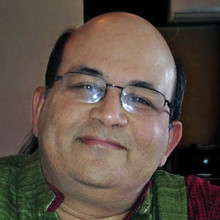[Photograph by Michal Jarmoluk under Creative Commons]
I am no expert on cancer, I am not even a doctor. But, I have always had some interest in modern biology, and read Siddhartha Mukherjee’s Pulitzer prize-winning masterpiece on the evolution of the fight against cancer, The Emperor of All Maladies, some years ago. So, I was intrigued when I heard that the Tata Memorial Centre (TMC) was organizing a conference on New Ideas and Challenging the Dogmas in Cancer as part of its platinum jubilee celebrations. I thought that this would be a good opportunity to understand the contemporary challenges in medical research and relate them to the broader context of innovation.
And I was not disappointed. Even for a novice like me, the TMC conference held in Mumbai in late February was a great learning experience since it had a stellar line-up of international speakers. One characteristic of truly great minds is the ability to articulate their ideas in simple terms; on this count, almost every speaker at the TMC conference was outstanding.
Cancer: The big picture
Cancer continues to be a major scourge of mankind. In 2010, the world saw 12.4 million new cases of cancer and 7.6 million deaths due to this disease. As many as 28 million people were living with cancer. Given the poor detection abilities of developing countries, this number is likely to be a gross underestimate.
In India, we have about a million new cancer patients every year, but only 150,000 patients get their first treatment. So, as many as 850,000 patients are not getting treated. Eighty percent of breast cancer patients in Finland are alive five years later; this is matched by India’s best cancer hospitals such as the Tata Memorial Hospital in Mumbai. But, the overall five-year survival rate for breast cancer patients in India is only 12%.
As many as 30 countries do not have even basic radiotherapy treatment centres.
Where do we stand?
Are we winning the war against cancer? What are the dogmas that come in the way of better cancer cure? And, what’s the way forward? These are some of the big questions that were asked at the conference.
My overall takeaway from the conference was that, like in many other fields of science and technology, we made great strides in cancer treatment in the 20th century. Getting surgery right and radiotherapy were the most significant advances. Chemotherapy has made a difference but the jury is split on whether the toll it extracts in terms of loss of quality of life due to its toxic effects is commensurate with the benefits it offers in terms of extended longevity.
But, momentous recent developments like the unravelling of the human gene, and the resultant new approaches such as personalized medicine and targeted therapies have not resulted in the advances that were hoped for. At least, not so far. Here, there is considerable divergence between the experts. The stereotypical American “can do” attitude is reflected in an optimism that a breakthrough is around the corner, while the more cautious European outlook is circumspect. Of course, it’s worth noting one important dimension of progress—the cost of gene sequencing has come down by a factor of 100 over the last decade.
At this point of time, personalised and targeted medicines seem to be more hype than reality. Combination therapies hold promise but there seem to be huge toxicity issues. New radiation therapies such as conformal radiotherapy and charged particle radiotherapy appear to offer only marginal improvements in efficacy, but at huge cost.
This appears to be part of a broad trend. For some years now, the frequency of discovery of breakthrough drugs has declined. In a thought-provoking talk, Jan Vijg of the Albert Einstein College of Medicine, USA, showed, using data on inventions across domains, that this is not an isolated phenomenon—the age of major technological progress that started with the industrial revolution is now over.
While there is now a general understanding of the triggers or broad causes of cancers, there isn’t a single theory that explains their growth. One of the outstanding talks at the TMC conference was by Carlos Sonnenschein of Tufts University. He advocates moving away from a cell-based theory of cancer such as the Somatic Mutation Theory (SMT) to what he calls a “Tissue Organization Field Theory” (TOFT). The latter is based on a societal view of cells. While the SMT is based on an assumption that the default state of a cell is quiescent and cancer is therefore a deviation from this default state, TOFT sees the default state of the cell as proliferation with variation and motility.
The talk by Sonnenschein, and another by Michael Baum of University College London on fractal geometries and their utility in understanding the underlying mechanisms of cancer, raised the hope that fundamental advances in cancer could happen in the near future. It was good to see this interest in theory—in many fields, the data revolution has led to a mad rush to find patterns in data without much concern for the underlying causal links.
The economics of cancer research
Both pharmaceutical and device companies came in for a lot of criticism during the conference. The main grouse against them was their aggressive marketing of therapies which offer only marginally improved benefits over existing therapies, but at huge, unaffordable costs. According to one speaker, about $300 billion was spent on cancer drugs over the past 15 years but the median gain was an extension of 2.2 months in patient longevity.
The indignation of the speakers was magnified because much of the basic research behind these therapies was publically-funded. Yet, if a company spends more than $2 billion on developing a new drug, is it surprising that it does everything it can to get specialists to prescribe its use? Aren’t attempts to “capture” the regulator also inevitable in such circumstances? And, it’s hardly surprising that there are increasing instances of manipulation of clinical trials data or dodgy reporting of trials results.
Many of the debates in medicine these days tend to be on cures, but the best returns on investment are in public health initiatives. Twenty percent of all deaths (and 30% of cancer deaths) in the US could be prevented by stopping the use of tobacco. But while the importance of prevention is well-accepted, the utility of screening continues to be contentious. According to Dr. Michael Baum, in the UK, screening for breast cancer started in the late 1980s with a philosophy of “Catch it early, save a life, and save a breast.” But, an increase in screening led to an increase in incidence. If deaths by treatment are included, harm from breast cancer screening exceeded its benefits. Based on these data, senior TMC doctors present at the conference were very sceptical about the benefits of mandatory screening for India.
Systematic collection of data on cancer incidence would help the fight against cancer. Maintenance of cancer registries with standardized reporting has helped scientists in France begin to see patterns in cancer incidence. India’s traditional aversion to good record-keeping and documentation may come in the way of our making similar progress unless we use technology such as the UID (Unique Identification Number, or Aadhaar) to start maintaining health records on the cloud.
Cancer moonshot: Is this the right time?
One of the fascinating discussions at the conference was on whether US President Barack Obama’s recently announced “moonshot” initiative on cancer makes sense or not. Speakers recalled that President Richard Nixon’s war against cancer 40 years ago had modest results. While some speakers felt that the portfolio of methods to combat cancer available today makes this the right time for such a major effort, others felt we simply don’t understand enough about cancer to make such a campaign successful now. But there was a fair degree of unanimity that a “cure” for cancer is not in sight; the best that can be hoped for is that cancer becomes treatable like a chronic disease.
The conference was a fertile spot for divergent thinking. Analogies were drawn across sectors and species. Unlikely connections made for interesting thoughts. One that I found particularly fascinating was the connection between the growth of low-cost airlines and an increase in the incidence of melanoma—as the frequency of travel of backpackers from the developed world to sunny destinations in Asia during winter has increased, so has the incidence of melanoma!
Final takeaways
One thing that is clear is that for developing countries in general, and India in particular, diffusion and adoption of the proven advances in cancer therapy rather than looking for new cures should be a priority. Efforts to lower the costs of therapy by frugal re-engineering on the radiotherapy device side and generic drugs on the chemotherapy side need to be complemented by training. Early detection is critical to successful cancer care, so spreading greater awareness would also help.
The exorbitant cost of the end-to-end new drug development process which results in new drugs that are not affordable anywhere makes one wonder whether the current innovation model is sustainable. Drugs for cancer are a particularly egregious example of this. The sequence of never-ending mega-mergers seen in the pharmaceutical industry over the past decade is a clear indicator of a crisis as is the increasing malpractice in trials and prescription. “Disruption” is a popular if somewhat over-used term these days. But, clearly, new drug development and commercialization is an area crying for disruption.


gunmeen kohli on Apr 26, 2016 10:18 a.m. said
link for the Author- (Alternative Cancer Research- Immunotherapy) http://www.fredhutch.org/en/news/center-news/2016/04/advanced-leukemia-remission-immunotherapy.html